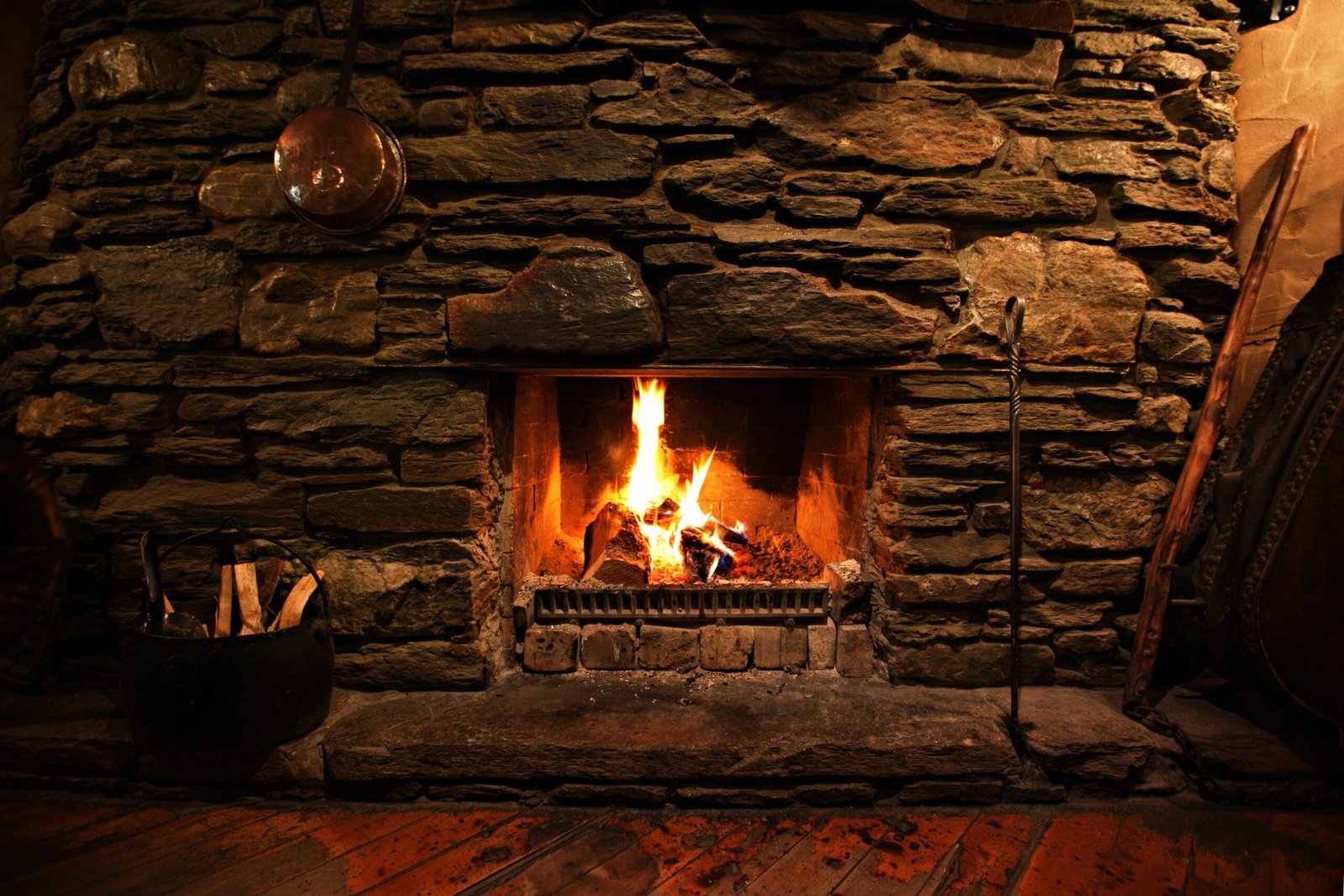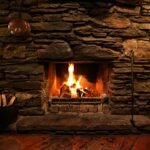Wood Fireplaces
There’s a certain magic in the crackling of a wood fireplace that can instantly transform a room into a warm and inviting space. In this comprehensive guide, we’ll delve into the world of wood fireplaces, covering everything from the various types available to their environmental impact, installation, maintenance, and so much more.
Types of Wood Fireplaces
Traditional Open Hearth Fireplaces
The traditional open hearth fireplace, with its cavernous firebox and large, ornate mantel, is a nostalgic symbol of warmth and comfort. These fireplaces evoke images of holiday gatherings, cozy storytelling, and a simpler time. Yet, their design, while charming, is not particularly energy-efficient.
These fireplaces are known for their large open hearths, designed to burn wood logs openly. While they provide an unmatched visual and auditory experience, their design allows a significant amount of heat to escape up the chimney. They are best suited for creating ambiance and are less efficient at heating a space compared to modern alternatives.
The Charm of Tradition
Despite their lower efficiency, traditional open hearth fireplaces have enduring appeal. The sound of crackling wood and the dancing flames provide a unique atmosphere, making them a focal point of any room. If you’re looking for nostalgia and ambiance, these fireplaces are the perfect choice.
Wood Stoves
Wood stoves have come a long way from their early, rudimentary designs. Modern wood stoves combine efficiency with elegance, making them an attractive and practical choice for heating homes.
Wood stoves are closed, cast-iron or steel appliances designed to burn wood efficiently. Their closed design allows for better control of combustion, which results in higher energy efficiency and less heat loss compared to open hearth fireplaces. They often feature a glass door, allowing you to watch the flames while ensuring that the majority of the heat remains in your living space.
Efficiency Meets Style
The efficiency of wood stoves makes them popular in regions with cold winters. They can effectively heat a room or an entire house, reducing the need for traditional heating systems. Wood stoves come in a variety of designs, from classic and vintage to sleek and modern, allowing you to choose one that complements your interior décor.
Fireplace Inserts
Fireplace inserts are a great choice if you have an existing masonry fireplace but want to improve its heating efficiency. These units are designed to fit snugly into your fireplace, effectively turning it into a wood-burning stove.
Fireplace inserts are known for their ability to maximize heat output while maintaining the traditional ambiance of an open hearth fireplace. They typically consist of a firebox, a decorative faceplate, and a blower or fan to circulate warm air. The firebox is often made of cast iron or steel and is highly efficient in burning wood
Efficiency and Convenience
The primary advantage of fireplace inserts is their efficiency. They can produce a substantial amount of heat and can distribute it effectively throughout your home. Many models also come with blowers or fans that help circulate warm air. This means you can enjoy the ambiance of a wood-burning fire while keeping your home warm and cozy.
Benefits of Wood Fireplaces
Energy Efficiency
When most people think of wood fireplaces, they envision the visual and auditory delights that they bring. What might not be immediately apparent, however, is their energy efficiency. In fact, modern wood fireplaces have made significant strides in heating efficiency.
The key to their efficiency lies in the design of wood stoves and fireplace inserts. These appliances are engineered to maximize heat output while minimizing heat loss. As a result, they can heat a room or an entire home effectively, reducing your reliance on traditional heating systems. This not only adds to your comfort but also potentially lowers your energy bills.
Energy Savings and Cost Efficiency
Using a wood fireplace as a supplemental heat source during the colder months can lead to noticeable energy savings. By reducing the workload of your central heating system, you can decrease your overall energy consumption and, subsequently, your heating bills. Plus, the warmth and ambiance provided by a wood fireplace are hard to match with other heating methods.
Aesthetic Appeal
There’s something inherently enchanting about the flickering flames and the warm, golden glow of a wood fireplace. The visual appeal of a wood-burning fire is one of the primary reasons people choose it as their heating source.
The beauty of a wood fireplace lies in its ability to create a warm, inviting atmosphere. The dancing flames draw the eyes, and the radiant heat wraps you in comfort. Whether you’re gathered with family and friends or enjoying a quiet evening alone, a wood fireplace can transform any space into a cozy haven.
A Focal Point of Design
Beyond their heating capabilities, wood fireplaces often become the focal point of a room’s design. Many homeowners choose to highlight their fireplace by decorating the mantel, creating an inviting seating area around it, or even incorporating it into custom cabinetry. The possibilities for design and personalization are endless.
Sustainability
Sustainability is a critical consideration in today’s world, and wood fireplaces can be part of the solution. The key to making wood fireplaces environmentally friendly is using wood from sustainable sources and employing eco-friendly practices.
Using Seasoned Wood
One of the essential practices for sustainable wood fireplace use is burning seasoned wood. Seasoned wood has been dried for an extended period, typically six months to a year, which reduces its moisture content. Dry wood burns more efficiently, producing more heat and fewer emissions. The process of seasoning also helps to prevent the buildup of creosote, which can be a fire hazard.
Reducing Emissions
Burning wood in an eco-friendly appliance designed to minimize emissions is another crucial aspect of sustainability. Modern wood stoves and inserts are often EPA-certified, meaning they meet stringent emission standards. These appliances are designed with the environment in mind, reducing the release of harmful particulates and gases into the atmosphere.
Responsible Wood Sourcing
The sustainability of wood fireplaces begins with responsible wood sourcing. Opt for firewood that comes from well-managed forests or woodlots. This ensures that the wood is harvested in a manner that maintains the health and diversity of the forest ecosystem. By choosing sustainably sourced wood, you contribute to the preservation of forests while enjoying the benefits of wood heating.
Choosing the Right Wood for Your Fireplace
Selecting the appropriate wood for your fireplace is crucial. Hardwoods like oak and maple burn slowly, producing long-lasting, high-temperature fires. Softwoods like pine ignite quickly but burn faster. Your choice should align with your heating needs.
Fireplace Installation and Safety
Location Considerations
Choosing the right location for your wood fireplace is crucial to ensure both effective heating and safety. The ideal placement can vary depending on the type of fireplace you have.
Open Hearth Fireplaces
Traditional open hearth fireplaces are often located in a central area of a home, such as a living room or den. They provide heat primarily through radiant energy, meaning they warm the immediate area. To maximize their heating potential, consider positioning them in a room where you spend the most time.
Wood Stoves
Wood stoves can be placed in various locations, but they are most effective when positioned in the center of the home or in a central hallway. This placement allows the stove to radiate heat throughout the living spaces. Keep in mind that wood stoves should be installed with proper clearances from combustible materials, so consult the manufacturer’s guidelines for specific installation requirements.
Fireplace Inserts
Fireplace inserts are designed to fit within an existing masonry fireplace. They offer an efficient way to transform an old, inefficient fireplace into a powerful heating source. When installing an insert, make sure it’s properly fitted into the fireplace opening, with all necessary clearances and safety measures in place.
Safety Precautions
Safety is paramount when dealing with wood fireplaces. Regular chimney inspections, proper ventilation, and the use of safety screens are essential to prevent accidents. Installing carbon monoxide detectors is also highly recommended for added safety.
Safety First
When it comes to wood fireplaces, safety should be your top priority. Here are some essential safety precautions to consider:
Regular Chimney Inspections
It’s vital to have your chimney inspected and cleaned regularly by a professional chimney sweep. Creosote buildup, debris, and obstructions can pose fire hazards and affect the efficiency of your fireplace.
Proper Ventilation
Adequate ventilation is essential to ensure the proper operation of your wood fireplace. Make sure your home has a fresh air intake to provide combustion air for the fire and prevent backdrafting, which can release harmful gases into your home.
Safety Screens and Barriers
Using safety screens or glass doors can help prevent sparks or embers from escaping the fireplace and landing on flammable surfaces. This is especially important for open hearth fireplaces.
Carbon Monoxide Detectors
Install carbon monoxide detectors in your home, especially near sleeping areas. These detectors can alert you to the presence of this odorless, colorless gas, which can be released during incomplete combustion.
Maintaining Your Wood Fireplace
Cleaning and Maintenance
Proper maintenance is the key to keeping your wood fireplace in excellent condition. Neglecting maintenance not only reduces the fireplace’s efficiency but can also pose safety risks.
Cleaning the Firebox
Regularly remove ashes from the firebox. Leaving a small layer of ash can actually insulate the coals, helping them burn longer and hotter. Empty the ash into a metal container and store it outdoors, away from flammable materials.
Chimney Cleaning
As wood burns, it releases creosote, a tar-like substance that can build up in the chimney. Creosote is highly flammable and poses a significant fire hazard. Have your chimney professionally cleaned at least once a year, or more frequently if you use the fireplace frequently.
Inspecting the Chimney
Regularly inspect the exterior of your chimney for any signs of damage, such as loose bricks, cracks, or damage to the mortar. These issues should be addressed promptly to prevent water infiltration and structural damage.
Checking Seals and Gaskets
Wood stoves and fireplace inserts often have seals and gaskets that can wear out over time. Check and replace these components as needed to maintain a tight seal, which is essential for proper combustion and efficiency.
Chimney Sweeping
While cleaning the firebox and maintaining the immediate area around your wood fireplace can often be handled by homeowners, chimney sweeping is best left to the experts. Professional chimney sweeps have the knowledge and tools to thoroughly clean and inspect your chimney, ensuring safety and efficiency.
Frequency of Sweeping
The frequency of chimney sweeping depends on how often you use your wood fireplace. If you use it frequently, especially during the winter months, an annual chimney sweeping is advisable. However, if it’s used less often, you might be able to stretch it to every two years.
Creosote Removal
One of the primary reasons for chimney sweeping is the removal of creosote buildup. Creosote is a highly flammable byproduct of wood combustion. If not removed, it can pose a significant fire hazard.
Chimney Inspection
Beyond cleaning, chimney sweeps also perform thorough inspections of your chimney. They look for structural issues, loose or missing bricks or mortar, and any signs of water damage. Early detection of these problems can prevent costly repairs later.
Eco-Friendly Practices with Wood Fireplaces
Using Seasoned Wood
The quality of the wood you burn directly affects the performance of your wood fireplace. Seasoned wood is your best choice for efficient and clean burning.
What Is Seasoned Wood?
Seasoned wood is wood that has been dried to reduce its moisture content. Freshly cut wood can have a moisture content of 45% or more, while seasoned wood typically contains 20% or less moisture. The drying process can take six months to a year or longer, depending on the type of wood and storage conditions.
The Benefits of Seasoned Wood
Burning seasoned wood offers several advantages. First, it produces more heat because less energy is wasted evaporating moisture. Second, seasoned wood burns cleaner, emitting fewer pollutants into the air. This is not only better for the environment but also safer for your chimney.
Proper Wood Storage
To season wood effectively, you need to store it properly. Wood should be split and stacked in a dry, well-ventilated area. Consider covering the top of the stack to protect it from rain and snow while allowing air circulation. A woodshed or covered wood rack works well for this purpose.
Reducing Emissions
Concerns about air quality and environmental impact have led to advancements in wood-burning technology. EPA-certified wood stoves and inserts are among the products designed to reduce emissions and make wood fireplaces more eco-friendly.
EPA Certification
The U.S. Environmental Protection Agency (EPA) sets strict standards for wood-burning appliances. Wood stoves and inserts that meet these standards are designated as EPA-certified. They are tested and proven to produce significantly fewer emissions, including particulate matter and volatile organic compounds (VOCs).
Cleaner Burning
EPA-certified wood stoves and inserts feature advanced combustion technology, including secondary burn systems that re-burn gases and particulates before they’re released into the atmosphere. This results in cleaner burning and fewer emissions.
Improved Efficiency
Along with reduced emissions, EPA-certified appliances are more energy-efficient. They produce more heat from less wood, which is not only good for the environment but also cost-effective for homeowners.
Wood Fireplace vs. Gas Fireplace
Choosing between wood and gas fireplaces is a matter of personal preference and lifestyle. Wood fireplaces offer timeless charm but require more maintenance, while gas fireplaces provide convenience and cleaner burning.
Conclusion
In summary, wood fireplaces offer not only warmth and aesthetic charm but also a world of possibilities for customization, cooking, and even a glimpse into the future of home heating. Embrace the versatility and beauty of wood fireplaces in your home.
FAQs
Are wood fireplaces energy-efficient?
Yes, wood fireplaces can be energy-efficient, especially when using modern wood stoves and inserts that maximize heat output.
Wood fireplaces, particularly those equipped with modern wood stoves or inserts, can be highly energy-efficient. These appliances are designed to burn wood efficiently and can heat a room or even an entire home effectively. By relying on a wood fireplace as a supplemental heat source, you can reduce your reliance on traditional heating systems, potentially lowering your energy bills.
Is burning wood in a fireplace bad for the environment?
It can be if not done responsibly. Using sustainably sourced wood and efficient appliances can minimize the environmental impact.
The environmental impact of burning wood in a fireplace largely depends on the wood’s source and the efficiency of the appliance. To reduce the negative impact, choose wood from well-managed forests or woodlots, and use an EPA-certified wood stove or insert. These appliances are designed to minimize emissions and maximize efficiency.
Can I install a wood fireplace in my home if I don’t already have one?
Yes, you can install a wood fireplace by adding a wood stove or fireplace insert to an existing masonry fireplace.
If you don’t have a wood fireplace in your home, you can still enjoy the benefits of wood heating by adding a wood stove or fireplace insert to an existing masonry fireplace. This allows you to transform an inefficient or unused fireplace into a powerful heating source. Consult with a professional for proper installation and safety considerations.
How often should I have my chimney cleaned?
Chimney cleaning should be done annually or more frequently if there is significant creosote buildup.
To maintain a safe and efficient wood fireplace, it’s advisable to have your chimney cleaned at least once a year. However, if you use your fireplace frequently, you may need more frequent cleanings to prevent the buildup of creosote, a highly flammable substance that can pose a fire hazard.
Are there any grants or incentives for using wood fireplaces in an eco-friendly manner?
Some regions offer incentives for using EPA-certified wood-burning appliances, so it’s worth checking with local authorities for potential programs.
In some areas, there are incentives and programs that encourage the use of eco-friendly wood-burning appliances, especially those that are EPA-certified. These incentives can include grants, tax credits, or rebates. Check with local environmental agencies or authorities to see if such programs are available in your region.


